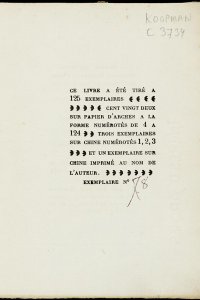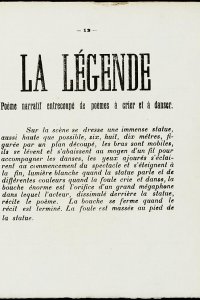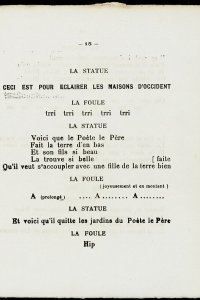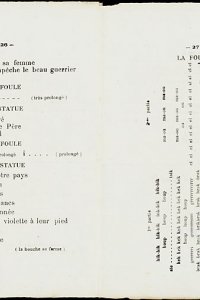La triloterie : poèmes composés en 1918
- Year:
- 1920
- Author:
- Pierre Albert-Birot (1876 - 1967)
- Artist:
- Léopold Survage (1879 - 1968)
- Publisher:
- Sic
The editions issuedby his publishing business were usually small, as a result of which an innovative book like Accordez-moi une audience… by Léonard Pieux, with colour woodcutsby Léopold Survage, is now less famous than it deserves to be. Albert-Birot hung paintings by Survage in his own home. The illustrator Survage produced a wood cutfor another issue of Sic, La triloterie, which was printed in black-and-white. Survage, who was actually named either Sturzwage or Sturzwasgh, was a Finnish-born artist who had discovered modern art through the art academy of Moscow and had moved to France in 1905, where Matisse was among his teachers. He painted murals there for the World Exhibition of 1937. The woodcut in La triloterie was typical of Cubism, in which figures are viewed and pictured from several perspectives at once.
Bibliographical description
- Description:
- La triloterie : poèmes composés en 1918 / Pierre Albert-Birot ; une grav. de Léopold Survage et un dess. en coul. de F.T. - Paris : Sic, 1920. - 60 p. : ill. ; 16 cm
- Printer:
- Impr. spéciale de Sic (Rirachowsky)
- Edition:
- 124 copies
- This copy:
- Nummer 78 van de 122 op Arches à la forme
- Bibliography:
- Bénézit 13-366 ; Monod 124
- Shelfmark:
- Koopm C 3734
References
- Paul van Capelleveen, Sophie Ham, Jordy Joubij, Voices and visions. The Koopman Collection and the Art of the French Book. The Hague, Koninklijke Bibliotheek, National Library of the Netherlands; Zwolle, Waanders, 2009
- Paul van Capelleveen, Sophie Ham, Jordy Joubij, Voix et visions. La Collection Koopman et l'Art du Livre français. La Haye, Koninklijke Bibliotheek, Bibliothèque nationale des Pays-Bas; Zwolle, Waanders, 2009
- Debra Kelly, Pierre Albert-Birot: A poetics in movement, a poetics of movement. Madison, Farleigh Dickinson University Press, 1997
- Marie-Louise Lentengre, Pierre Albert-Birot: L'invention de soi. Paris, Place, 1993
- Sic. Paris, Place, 1980
- Pierre Albert-Birot: Laboratoire de modernité. Paris, Place, 1997
- W. J. Strachan, The artist and the book in France: The 20th century livre d'artiste. London, Owen, 1969


![Houtsnede 'La statue' door Léopold Survage op pagina [11]](/sites/default/files/styles/galerie/public/images/triloterie-p11.jpg?h=916ab959&itok=EosBI77j)

![Illustration by F.Torowai between page [30] and 31](/sites/default/files/styles/paragraph_small_no_crop/public/images/triloterie-p30-31.jpg?itok=ON08phcv)


![Laatste tekstpagina (p. [60])](/sites/default/files/styles/galerie/public/images/triloterie-p60.jpg?h=e7495fab&itok=KUrQm7iB)